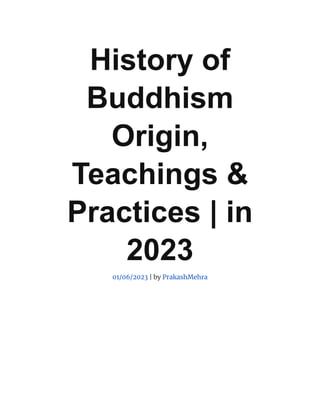
History of Buddhism Origin, Teachings & Practices | in 2023
- 1. History of Buddhism Origin, Teachings & Practices | in 2023 01/06/2023 | by PrakashMehra
- 2. Buddhism is a major world religion that originated in ancient India around the 5th century BCE. It was founded by Siddhartha Gautama, who later became known as Gautama Buddha. Its teachings and philosophy revolve around understanding and overcoming suffering to achieve enlightenment. Buddhism has spread to various parts of the world and has influenced diverse cultures. It offers philosophical and practical teachings aimed at understanding the nature of suffering and attaining liberation from it through enlightenment.
- 3. Buddhism is a religion and philosophical system that encompasses a wide range of beliefs, practices, and traditions. Here is some additional information about Buddhism Origins Buddhism was founded by Siddhartha Gautama, also known as Gautama Buddha, in ancient India around the 5th century BCE. Siddhartha was born into a wealthy family but renounced his privileged life in search of spiritual truth. After years of meditation and self-discovery, he attained enlightenment under a Bodhi tree and began teaching his insights to others.
- 4. Core Teachings: The central teachings of Buddhism revolve around the Four Noble Truths and the Eightfold Path. The Four Noble Truths explain the existence of suffering (dukkha), its causes, its cessation, and the path to end it. The Eightfold Path
- 5. outlines the practical steps for individuals to follow in order to achieve liberation from suffering and reach enlightenment. Concept of Enlightenment Enlightenment, or Nirvana, is the ultimate goal of Buddhism. It refers to the state of complete awakening and liberation from the cycle of birth, death, and rebirth. Attaining enlightenment involves gaining deep insight into the true nature of reality, letting go of attachment and craving, and cultivating wisdom, compassion, and ethical conduct.
- 7. Concept of Reincarnation and Karma Buddhism teaches that individuals go through a cycle of rebirths known as samsara. Rebirth is determined by the accumulation of karma, which refers to the consequences of one’s intentional actions. Positive actions lead to positive karma, which can result in better future lives, while negative actions generate negative karma and contribute to suffering.
- 8. Monasticism and Lay Practitioners Buddhism has a strong tradition of monasticism, where monks and nuns renounce worldly life and devote themselves to the pursuit of enlightenment. Monastic communities provide spiritual guidance, preserve the teachings, and serve as centers of learning. However, it also recognizes the importance of lay practitioners who live in the world and strive to follow Buddhist principles in their daily lives.
- 9. Scriptures The primary scriptures of Buddhism are known as sutras or sutta, which record the teachings of the Buddha and his disciples. Different Buddhist traditions have their own collections of scriptures. The earliest and most well-known
- 10. collection is the Pali Canon. They considered authoritative in Theravada Buddhism. Mahayana Buddhism has its own sutras, such as the Lotus Sutra and the Heart Sutra. Spread and Variations Buddhism has spread across many countries and regions, leading to the development of various schools and traditions. Theravada Buddhism is prominent in Southeast Asia, while Mahayana Buddhism is prevalent in East Asia, including China, Japan, and Korea. Vajrayana Buddhism is practiced primarily in Tibet and neighboring regions. Influence Buddhism has had a profound impact on art, literature, philosophy, and culture in the countries where it has taken root. Buddhist concepts such as mindfulness, compassion, and non-attachment have gained popularity beyond religious boundaries and have influenced various aspects of contemporary society. Key Beliefs: 1. Four Noble Truths: Buddhism identifies four truths about the nature of existence: the truth of suffering, the truth of the origin of suffering, the truth of the cessation of suffering, and the truth of the path that leads to the cessation of suffering. 2. Eightfold Path: This path consists of eight interconnected principles or practices that aim to guide individuals towards enlightenment. It includes right understanding, right thought, right speech, right action, right livelihood, right effort, right mindfulness, and right concentration. 3. Karma and Rebirth: Buddhism believes in the concept of karma, which states that actions have consequences. Positive actions lead to positive outcomes, while negative actions result in suffering.
- 11. Rebirth or reincarnation is also a fundamental belief, where individuals are born into different forms based on their karma. Major Branches: 1. Theravada Buddhism: Predominant in Southeast Asia, Theravada emphasizes individual enlightenment and follows the earliest Buddhist scriptures known as the Pali Canon. 2. Mahayana Buddhism: Widespread in East Asia, Mahayana emphasizes the pursuit of enlightenment for the benefit of all beings and acknowledges the existence of enlightened beings called bodhisattvas. 3. Vajrayana Buddhism: Found mainly in Tibet and Nepal, Vajrayana incorporates tantric practices and rituals to achieve enlightenment quickly. It places a strong emphasis on meditation and the use of mantras and visualizations. Practices 1. Meditation: A core practice in Buddhism, meditation aims to develop mindfulness, concentration, and insight. There are various meditation techniques, such as mindfulness meditation, loving-kindness meditation, and insight meditation. 2. Monastic Life: Monks and nuns renounce worldly possessions and dedicate their lives to the practice and study of Buddhism. Monastic communities serve as centers of learning and spiritual guidance. 3. Rituals and Offerings: Buddhist practitioners often engage in rituals, ceremonies, and the offering of flowers, incense, and food to express devotion and cultivate positive karma. 4. Mindful Living: Buddhists strive to cultivate mindfulness in their daily lives, being aware and present in each moment, and practicing compassion, kindness, and ethical behavior towards oneself and others.
- 12. Conclusion Buddhism has spread to various parts of the world and has influenced diverse cultures. It offers philosophical and practical teachings aimed at understanding the nature of suffering and attaining liberation from it through enlightenment.It’s important to note that this is a brief overview of Buddhism, and there are many more aspects, practices, and complexities within the religion. Buddhism’s depth and diversity make it a fascinating subject for exploration and study